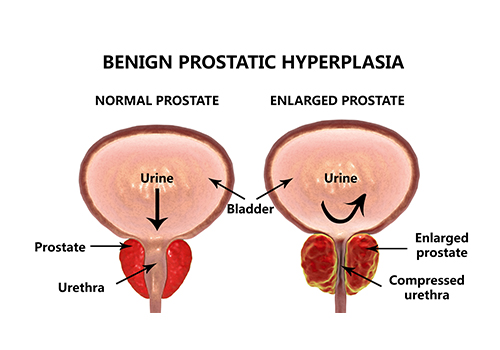 Treatment for a man’s enlarged prostate can be individually tailored to one’s symptoms and needs, and may change over time.
Treatment for a man’s enlarged prostate can be individually tailored to one’s symptoms and needs, and may change over time.
Behavioral modifications
Some effective measures can be simple and achievable without any medical therapy. These may include simply drinking less fluid at night, decreasing one’s caffeine intake, or decreasing one’s alcohol consumption.
Vitamin and herbal supplements
To date, there is no proof that any of these supplements provide any benefit to flow of urine or urinary symptoms. Saw Palmetto, one of the more popular supplements used by men, has been shown to provide no benefit of placebo.
Meds
Flomax, Uroxatral, Rapaflo, Cialis, Cardura, Hytrin
This class of drugs relaxes the muscles in and around the prostate, allowing the flow of urine to increase. These medications increase the flow through the inner prostate channel. Although they work well, they do have many potential side effects, such as sexual problems, blood pressure changes, and sinus congestion.
Proscar, Avodart
This class of drugs help to shrink the prostate, which will hopefully allow a better flow. These can be used in conjunction with the medications listed above. They can also have some potential side effects, including erectile dysfunction, gynecomastia, and change in PSA level.
Office based procedures we offer
UroLift®
UroLift® is one of the most common office based procedures currently being performed for BPH. It works by lifting or moving the obstructing prostate tissue out of the way so that it no longer blocks the flow of urine. The UroLift® procedure can be performed comfortably while fully awake, with laughing gas, or sometimes your physician will elect to give a minor general anesthetic. The procedure generally takes just a few minutes to perform and the results last for years. The UroLift® procedure is safe and effective at relieving urinary symptoms without any impact to sexual function.
Learn More
Surgical procedures we offer
Trans-urethral resection of the prostate (TURP)
The TURP is the classic, oldy-but-goodie operation to relieve obstructing prostate tissue. The man is generally put to sleep by an anesthesiologist and an electric cautery is used to remove tissue from the inner aspect of the prostate. This is all performed through the urethra and requires no cutting of the skin or external scars or healing. The TURP procedure is an extremely effective method of relieving significant urinary symptoms, but does require a significant recovery period. The beneficial effects of this operation can last for years, or even be lifelong. In addition, there can be some long-term side effects including changes in sexual function.

Greenlight Laser Prostatectomy
Just like the TURP, The Greenlight Laser Prostatectomy is a surgical procedure designed to relieve or remove obstructing prostate tissue, but uses a laser to vaporize instead of a cautery to remove the tissue. It is also performed through a man’s urethra and without external cutting or scarring. The long-term benefits and potential side effects of the Greenlight Laser Prostatectomy are similar to the TURP. Whether one is better off with a TURP or Greenlight Laser Prostatectomy is at the discretion of the urologic surgeon and the shape of a man’s prostate.
DaVinci Suprapubic Prostatectomy
For very large prostates, one of the most effective methods of relieving the obstruction is to surgically remove the tissue. This is more invasive than the other surgeries, but for very large prostates it offers the most durable and lasting result. Using the DaVinci Surgical System, the inner aspect of the obstructing prostate tissue is removed using laparoscopic instruments. This operation requires general anesthesia, an overnight hospital stay, and several weeks of recovery afterwards. There can be some significant short-term side effects, but the long-term benefits to a man’s urinary system can be tremendous and lifelong. This operation is generally reserved for the largest prostates for which other less invasive options simply would not be as effective.
 Benign Prostatic Hyperplasia (BPH) is non-cancerous growth of a man’s prostate.
Benign Prostatic Hyperplasia (BPH) is non-cancerous growth of a man’s prostate. Treatment for a man’s enlarged prostate can be individually tailored to one’s symptoms and needs, and may change over time.
Treatment for a man’s enlarged prostate can be individually tailored to one’s symptoms and needs, and may change over time.

